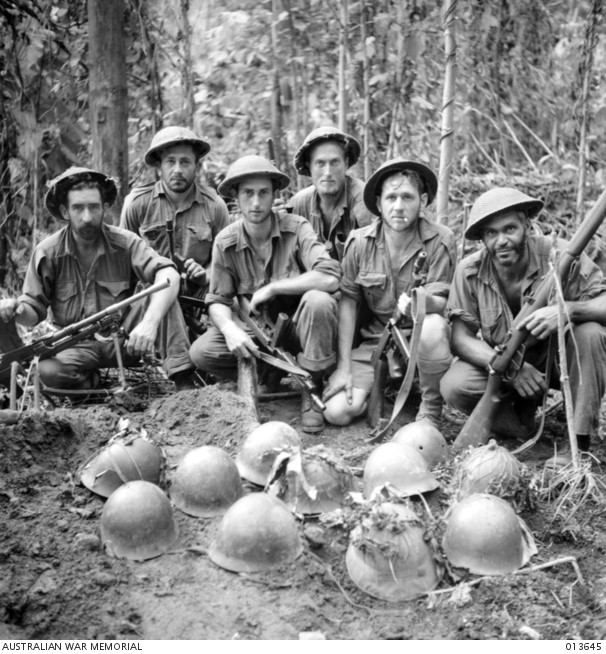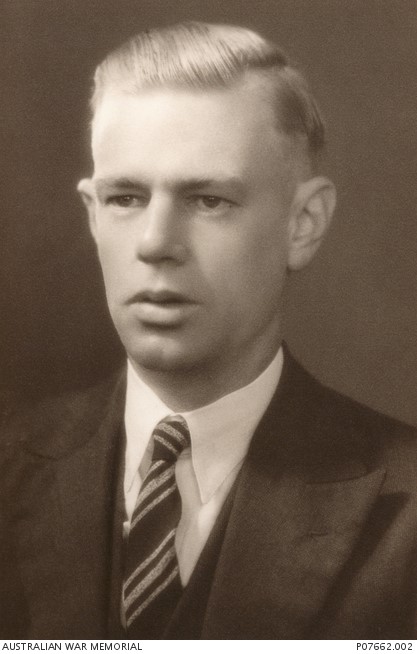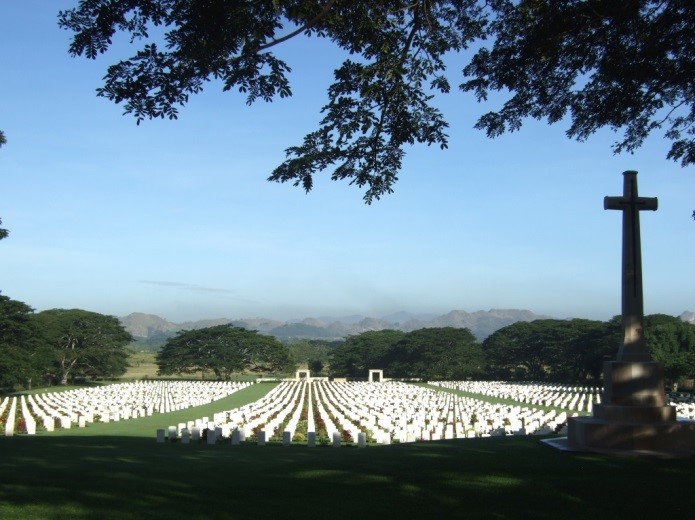Lieutenant Kenneth Sydney Robertson, the son of Sydney Robertson and Emily Gertrude Robertson (nee Henzell) was born at Brisbane in Queensland on 4th May 1909. He was educated at the Toowoomba Grammar School. At the age of 31 years he voluntarily enlisted in the Australian Imperial Force at Kelvin Grove in Brisbane on 11th June 1940 after giving a commitment that he would serve for the duration of the war and an additional twelve months. He was allotted the regimental number of QX8992. At the time of enlistment he was employed as a solicitor in his father’s law practice, S. Robertson & Son. He had previously served in the Citizen Military Forces as a Sergeant in the 61st Infantry Battalion. His physical description was that he had fair hair and blue eyes. He stated that he was of the Presbyterian religion. He gave his next of kin as his father, Sydney Robertson, residing at Henzell Terrace, Greenslopes, Brisbane.
Lieutenant Kenneth Robertson joined No. 2 Anti-Tank Regiment at Redbank Camp on 13th June 1940. He was transferred to the 2nd/25th Infantry Battalion at Grovely Camp on 21st August 1940. The 2nd/25th Infantry Battalion was formed at Grovely on 1st July 1940. He was promoted to the rank of Acting Corporal on 13th September 1940. On 11th October the Battalion presented itself to the public of Queensland by marching complete with rifles with bayonets attached through the streets of Brisbane. In the afternoon of 15th October 1940 the Battalion left Grovely Camp and proceeded to the Pinkenba Wharf on the Brisbane River where they boarded the sea transport “Zealandia” for its voyage to Darwin in the Northern Territory via the Queensland Coast and Torres Strait. The battalion disembarked from the ship at Darwin on 23rd October 1940. Intensive training including weapon training, map reading, patrolling, manoeuvres, marches and beach defence was conducted in the Darwin area. On 15th February 1941 the Battalion boarded the “Zealandia” for its return to Queensland. The ship berthed at Brisbane on 24th February 1941 and the unit entrained for Redbank Camp on 24th February 1941.
Lieutenant Kenneth Robertson was granted pre-embarkation leave during the period 28th February until 12th March 1941 to farewell his family and finalize his personal affairs prior to embarking for overseas service in the Australian Imperial Force. His battalion left Brisbane by rail transport on 6th April 1941 and proceeded to Sydney where they boarded a transport ship “Queen Mary” on the following day. The “Queen Mary” departed Sydney for the Middle East early in the morning of the 9th April. The Queen Mary sailed via Fremantle in Western Australia to Trincomalee Harbour, Ceylon. After leaving Trincomalee the ship sailed to Aden and the Red Sea. It arrived at Port Tufik at the entrance to the Suez Canal on 3rd May 1941. The Battalion disembarked from the ship on 5th May 1941 and proceeded by rail transport to Ikingi Maryut. The Battalion then moved to Mersa Matruh on 9th May 1941 and arrived there shortly after midnight. The Battalion proceeded to Ismailia on 27th May and crossed the Suez Canal by ferry to El Kantara on the Palestine side.
Lieutenant Kenneth Robertson was evacuated to the 7th Australian General Hospital suffering from mumps on 31st May 1941 and he was transferred to No. 1 Australian Convalescent Depot on 12th June 1941. Upon recovering from his illness he joined the 24th Australian Infantry Training Battalion on 27th June 1941. He rejoined the 2nd/25th Battalion in the field at Saida in Syria on 26th June 1941. The Battalion had moved across the border into Syria on 8th June 1941 and it advanced and engaged the Vichy French forces. He was evacuated to the 14th Australian Field Ambulance Unit suffering from Impetigo on 20th July 1941 and he remained a patient there until 27th July 1941 when he rejoined his battalion near Beirut. He was promoted to the rank of Acting Sergeant 1st October 1941. His rank of Sergeant was confirmed on 1st December 1941.
Lieutenant Kenneth Robertson embarked with his Battalion on the “U.S.S. Mount Vernon” on 8th February 1942 to return to Australia to meet the Japanese threat. The ship arrived at Colombo on the morning of 18th February 1942. The ship left Colombo and arrived at Fremantle on 4th March 1942. The ship set sail for Adelaide and the Battalion disembarked there on the morning of 10th March 1942. The Battalion then moved to Woodside Camp where further military training was carried out. The Battalion moved to Casino in New South Wales during 26th/27th April 1942. He was granted home leave during the period 1st May until 9th May 1942. On 27th May 1942 the Battalion moved to Caboolture in Queensland where it was assigned a portion of the coast for coast watching. He was detached for duty with the 5th Motor Regiment during the period 9th May until 3rd June 1942. The battalion embarked from New Farm Wharf in Brisbane on 31st August 1942 on the ships S.S. Katoomba and S.S. Van Der Lijn and he disembarked at Port Moresby on 9th September 1942. He was promoted to the rank of Lieutenant on 19th September 1942. The battalion left the staging camp at Port Moresby and proceeded up the Kokoda Track to engage the retreating Japanese.
The battalion had their first action at Ioribaiwa on 14th September 1942. Kenneth Robertson was killed in action on 9th November 1942 during the Australian advance at the Battle of Oivi-Gorari. On the day that he was killed the 2nd/25th Infantry Battalion suffered its heaviest single day of casualties with 12 members killed and 17 wounded. At the time of his death he was 33 years of age. In their retreat over the Kokoda Track the Japanese had established an extensive defence network in the Oivi-Gorari area. During a series of major contacts the Australians killed approximately 1000 Japanese with the loss of approximately 130 of their own men. He was buried in the field in the Wairope Area on 10th November 1942. His remains were exhumed on 20th January 1946 and reburied in the Soputa War Cemetery. His remains were finally laid to rest when they were concentrated into the Port Moresby (Bomana) War Cemetery. His headstone contains the family inscription “Your memory hallowed in the land you loved”.
Lieutenant Kenneth Robertson’s name is commemorated on Panel No. 52 at the Australian War Memorial in Canberra and locally on the Toowoomba Grammar School WW2 Honour Board.
Note
His brother, Pilot Officer Ian Ronald Robertson (404657) was killed on 25th October 1943 whilst serving on attachment to the Royal Air Force. He was the navigator of a Lancaster Bomber that was lost during a mine-laying operation over the Baltic Sea. His body was washed ashore in Denmark and he was buried in the Copenhagen (Bispebjerg) Cemetery in Denmark.
His mother received a Female Relative Badge with two stars on 9th May 1942.

Australian War Memorial photograph 013645
The Tide Turns – Japanese Forces are forced to retreat
The grave of 11 dead Japanese soldiers killed at Gorari who were buried in a common grave.




